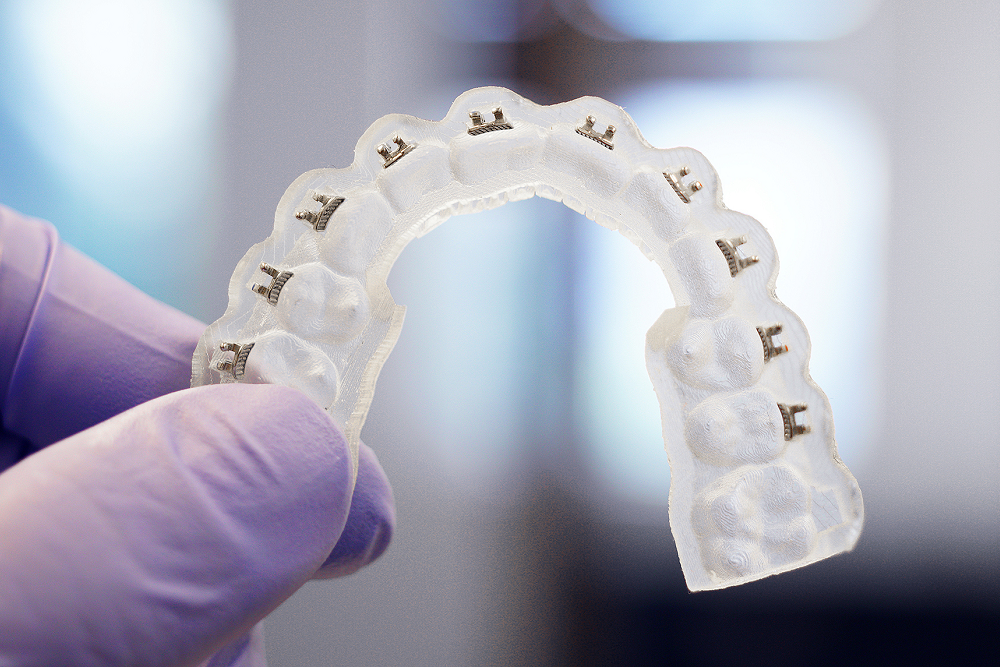
Three Benefits of 3D-Printed Indirect Bonding Trays
Dental procedures involve precise manual processes, both when working in a patient’s mouth and fabricating dental appliances. Products like clear aligners and night guards require manual fabrication and finishing steps to ensure a comfortable fit in the patient’s mouth. Many dental practices and labs now use 3D printing to manufacture dental appliances. 3D printing provides multiple benefits from a cost and efficiency perspective. Newer 3D printing systems are easy to use, require little training, and simplify with a digitalized workflow for printing dental products.
The right printing process and advanced materials can also produce 3D-printed indirect bonding trays. Practices that bring 3D printing in-house use a single system and process to produce numerous dental appliances. In addition, practices can eliminate many expensive, time-consuming tasks involved in the traditional fabrication of indirect bonding trays, ultimately reducing costs for patients and expediting treatment.

Traditional vs. 3D-Printed Indirect Bonding Trays
The first step involved in fabricating an indirect dental model is to create a mold of the patient’s teeth, typically from an impression. From there, the orthodontist uses the impression to cast a model of the patient’s teeth from a material like gypsum or dental stone. They will then position each bracket manually and thermoform the tray material around the teeth in a vacuum system. Once removed from the model, they coat the brackets with a bonding agent to fix them to the patient’s teeth, and the bond cures through the tray using a UV lamp.
In contrast, 3D printed indirect bonding trays involve a similar process to the one used to print clear aligners and retainers. After gathering an intraoral scan of the patient’s mouth, the tray prints directly with high accuracy. Before printing, an orthodontist uses a CAD model of the patient’s mouth to place brackets on the teeth digitally. They can digitally define the indirect bonding tray around the patient’s teeth and brackets. After exporting an STL model of the tray, it can print directly with accurately placed cutouts for the brackets included in the final product.
Four significant benefits of using 3D-printed indirect bonding trays arise when comparing the traditional process with 3D printing.
1. Fewer Manual Steps
3D printing eliminates most of the manual steps involved in the traditional indirect bonding tray manufacturing process. By eliminating manual fabrication steps, the total fabrication time for 3D printed indirect bonding trays reduces. The best 3D printing systems for dental products will interface with treatment planning software so an orthodontist can quickly form a tray model over the teeth and bracket model. They can then immediately export the resulting model to a 3D printer. Most importantly, dental labs and practices can expedite treatment while reducing their costs and passing savings onto patients.
2. 3D Printed Trays Have Higher Accuracy
Thermoformed products typically require manual cutting and trimming processes to produce a product with a comfortable fit in a patient’s mouth. This process includes manual grinding and adjustment at tooth surfaces after fabrication is complete. 3D printers that use advanced optical processes like DLP produce indirect bonding trays with sub-millimeter accuracy. Accuracy includes slots for brackets embedded in the bonding tray. The process eliminates manual adjustments traditionally required and ensures a more comfortable fit to the patient’s mouth.
3. Transparent and Compliant
Advanced dental 3D printers that use optical processes accommodate multiple dental resins with highly tunable material properties. Rather than forcing practices or labs to adjust the resin composition themselves, the best 3D printing companies supply a range of advanced resins for direct printing of dental appliances. These resins allow an indirect bonding tray to print transparent while also being somewhat flexible so brackets can accurately fit the patient’s teeth. This flexibility makes the tray easier to adjust and remove during a procedure. Additionally, transparent bonding trays allow for complete UV curing in a shorter time than their translucent counterparts.
Streamline Dental Manufacturing with 3D Printing
The major advantage of 3D printing systems over other manufacturing methods is that 3D printers do not require any tooling. Systems that use photosensitive resins for dental production require very little post-processing, amounting to only a simple wash and cure step. Because a single printing system can adapt to many different products, dental labs and practices can streamline the delivery of dental appliances with an on-demand production model. Labs and practices can fabricate appliances like 3D-printed indirect bonding trays, aligners, and dental models and put them to use the same day, ultimately providing a more positive experience for patients.
LuxCreo’s patented LEAP™ (Light Enabled Additive Production) process enables high-mix, low-volume manufacturing of 3D-printed indirect bonding trays, dental models, clear aligners, and many other dental appliances from a range of specialized FDA-approved resins. Dental labs and offices can take advantage of flexible on-demand production in-house or in a Smart Factory with cloud-connected 3D printers. For more information on how our printers and services can improve your supply chain and manufacturing processes, visit our contact page or call (650) 336-0888.

